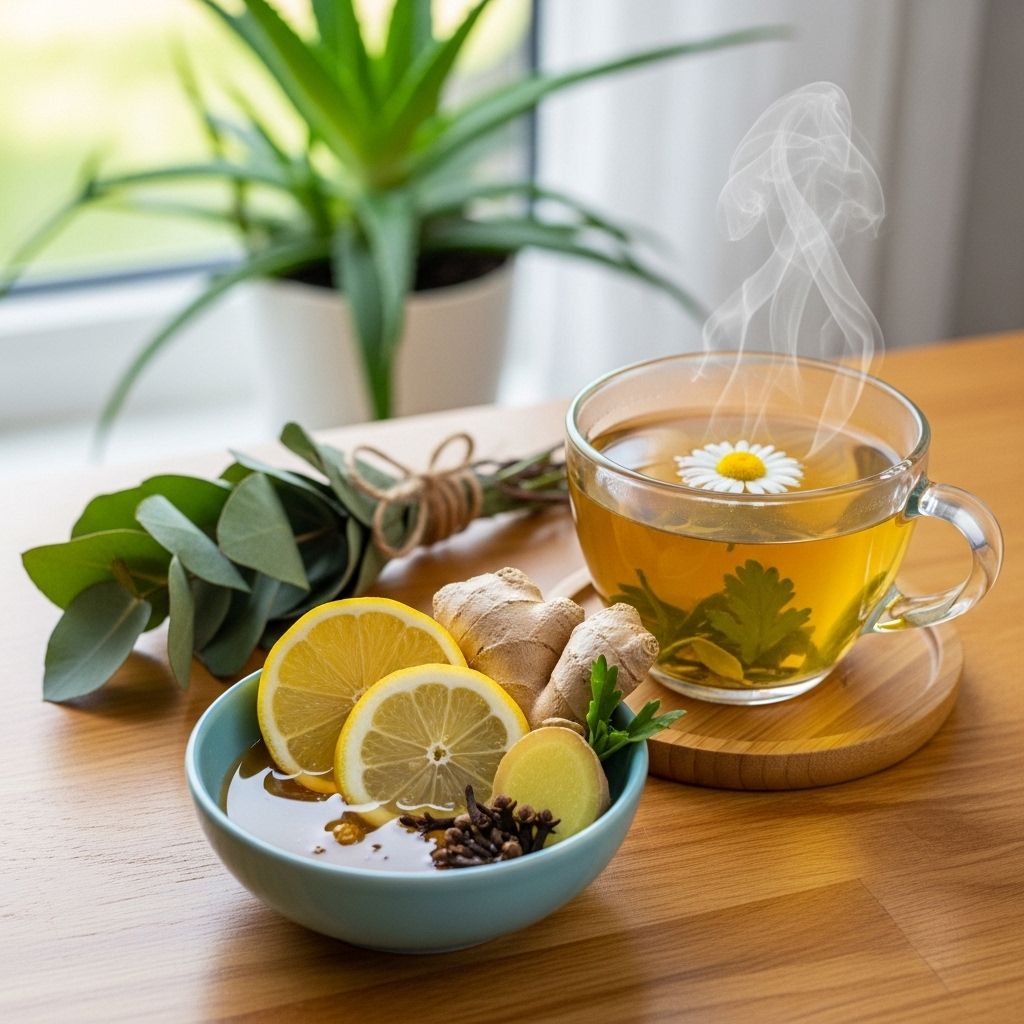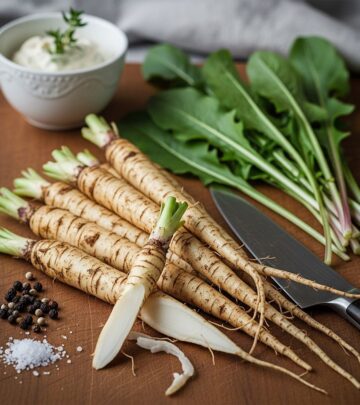9 Effective Home Remedies To Manage Asthma Naturally
Ease respiratory discomfort with pantry staples you already have at home.

Asthma is a chronic respiratory condition that affects millions worldwide, causing symptoms like chest tightness, wheezing, shortness of breath, and coughing. While traditional medical treatments are crucial for controlling asthma, many people seek complementary remedies at home to help reduce discomfort, soothe airways, and manage their symptoms more effectively. Below, we explore nine science-backed home remedies—ranging from kitchen staples to breathing exercises and essential oils—designed to ease asthma naturally. Always consult your healthcare provider before using home treatments, and never substitute prescribed medication with natural remedies alone.
Table of Contents
- Asthma: Overview & Symptoms
- Kitchen Remedies For Asthma Relief
- Aromatherapy & Essential Oils
- Lifestyle Management & Breathing Techniques
- Dietary Support & Nutrition
- Frequently Asked Questions (FAQs)
Asthma: Overview & Symptoms
Asthma is a condition where the airways become inflamed, swollen, and narrow, producing extra mucus that makes it hard to breathe. Common symptoms include:
- Persistent cough that won’t go away
- Shortness of breath
- Rapid breathing
- Wheezing sounds while exhaling
- Pale and sweaty skin
Symptoms may vary from mild to severe and can be triggered by allergens, pollutants, exercise, stress, or viral infections. While there is no cure for asthma, proper management—including medication and healthy lifestyle practices—can significantly improve quality of life.
Kitchen Remedies For Asthma Relief
Nine common kitchen remedies can help alleviate mild asthma symptoms, reduce airway inflammation, and clear congestion. These strategies should complement, not replace, prescription medications.
1. Honey
Honey is an ancient remedy for respiratory discomfort due to its anti-inflammatory, antimicrobial, and soothing properties.
- How To Use: Mix one teaspoon of honey in a glass of warm water and drink slowly. Swallow another teaspoon of honey mixed with half a teaspoon of cinnamon powder before bed.
- Frequency: Drink honey water thrice daily. Take the honey-cinnamon mix before sleep.
- Why It Works: Honey eases throat irritation, clears mucus, and supports restful sleep by reducing nighttime coughing.
2. Ginger
Ginger is well-known for its potent anti-inflammatory benefits and has been used for decades to support lung health.
- How To Use: Grate one teaspoon of fresh ginger, add to a cup of hot water, steep for 5–7 minutes, strain, and add half a teaspoon of honey. Drink warm as herbal tea, or chew a small piece of ginger throughout the day.
- Frequency: Sip 2–3 cups of ginger tea daily.
- Why It Works: Ginger relaxes airway muscles, regulates calcium uptake, and relieves bronchial constriction, leading to easier breathing.
3. Garlic
Garlic has immune-boosting, anti-inflammatory, and antimicrobial properties that make it useful in maintaining lung health.
- How To Use: Crush or finely chop 2–3 cloves of garlic, boil in milk, and drink once cooled. Alternatively, add garlic to daily dishes as seasoning.
- Frequency: Once a day, or regularly via diet.
- Why It Works: Garlic may help reduce inflammation in airways and clear mucus, contributing to easier breathing.
4. Turmeric
Turmeric is a powerhouse spice with strong anti-inflammatory and anti-allergy properties, largely thanks to curcumin, its active compound.
- How To Use: Mix half a teaspoon of turmeric powder in a glass of warm milk. Drink once or twice daily.
- Frequency: Once or twice per day.
- Why It Works: Turmeric helps suppress allergic reactions, reduce airway swelling, and fight infections that may trigger asthma.
5. Coffee & Caffeinated Drinks
Caffeine, found in coffee, tea, and cocoa, can have a similar effect as theophylline, a bronchodilator used medically for asthma.
- How To Use: Drink a cup of black coffee or tea during mild asthma episodes.
- Frequency: 1–2 cups per day during symptomatic periods.
- Why It Works: Caffeine may relax airway muscles and open up constricted respiratory passages temporarily.
6. Omega-3 Fatty Acids
Omega-3 oils, found in fatty fish, flaxseed, and walnuts, have robust anti-inflammatory effects.
- How To Use: Incorporate foods rich in omega-3 fats, such as salmon, sardines, chia seeds, or flaxseed oil, into your diet.
- Frequency: As a regular part of meals.
- Why It Works: Omega-3s may help reduce airway inflammation and lower frequency of asthma attacks.
7. Steam Therapy
Steam inhalation helps moisten dry airways, loosen mucus, and relieve congestion.
- How To Use: Boil water, carefully inhale the steam (with or without a towel over your head) for five to ten minutes. You can add essential oils for enhanced benefits.
- Frequency: Once daily or as needed during symptom flare-ups.
- Why It Works: Steam clears nasal and chest congestion, helping ease breathing and reduce discomfort.
Aromatherapy & Essential Oils
Essential oils like lavender and tea tree oil have notable anti-inflammatory and expectorant effects, useful for easing asthma discomfort.
(a) Lavender Oil
- How To Use: Add 5–6 drops of lavender oil to a bowl of hot water. Inhale the steam for five to ten minutes.
- Frequency: Once daily.
- Why It Works: Lavender oil inhibits airway inflammation, calms irritation, and controls mucus production.
(b) Tea Tree Oil
- How To Use: Dampen a face cloth in warm water, wring out excess, add a few drops of tea tree oil, and inhale vapors until the cloth cools.
- Frequency: Repeat as needed during symptom episodes.
- Why It Works: Tea tree oil’s expectorant and decongestant qualities help relieve wheezing and coughing, reduce inflammation, and combat respiratory infections.
Lifestyle Management & Breathing Techniques
Adopting simple lifestyle changes and specific breathing exercises can dramatically improve asthma management, lung capacity, and symptom control.
1. Breathing Exercises
- Pursed-lip breathing: Inhale slowly through your nose, then exhale via pursed lips. This exercise expels stale air from lungs and helps you take in more oxygen.
- Belly (diaphragmatic) breathing: Breathe slowly, letting your abdomen expand—focus on deep, even breaths for several minutes daily.
- Frequency: Practice 5–10 minutes, 1–2 times per day.
2. Yoga & Meditation
- How To Use: Practice gentle yoga poses and meditation techniques to build lung strength, relax airways, and improve overall respiratory health.
- Benefits: Yoga calms the mind, reduces stress triggers, and improves lung function—a key factor for asthma control.
3. Exercise
- How To Use: Engage in moderate physical activity tailored to your condition, such as brisk walking, cycling, or swimming.
- Frequency: 20–30 minutes, most days of the week.
- Benefits: Regular exercise boosts lung capacity and cardiovascular strength, provided it does not trigger asthma attacks (consult your doctor for a suitable plan).
Dietary Support & Nutrition
Nutritional adjustments can significantly benefit asthma patients, supporting allergic response reduction and better overall lung health.
- Increase Antioxidants: Foods like berries, leafy greens, carrots, and apples are high in antioxidants that help fight airway inflammation.
- Avoid Food Allergens: Identify and exclude foods that may trigger asthma, such as dairy, eggs, or specific additives.
- Maintain Healthy Weight: Avoiding obesity can ease the severity and frequency of asthma attacks.
Sample Table: Comparison of Common Home Asthma Remedies
| Remedy | Active Benefits | Usage | Cautions |
|---|---|---|---|
| Honey | Soothes throat, clears mucus | Mixed in warm water or with cinnamon | Avoid in infants & those allergic to pollen |
| Ginger | Relaxes airway, anti-inflammatory | Herbal tea or direct chewing | May interact with certain medications |
| Garlic | Reduces inflammation, antimicrobial | Boiled with milk or as seasoning | Strong flavor, allergies rare but noted |
| Lavender Oil | Inhibits airway inflammation | Steam inhalation | Essential oils not for oral use |
| Coffee/Caffeine | Bronchodilation | Black coffee or tea | Limit intake; avoid high doses |
Frequently Asked Questions (FAQs)
Q: Can home remedies cure asthma completely?
A: No home remedy has been scientifically proven to cure asthma completely. Home treatments may provide symptom relief but should always be used alongside prescribed medications. Medical management remains essential for controlling asthma and preventing severe attacks.
Q: Is it safe to use essential oils for asthma?
A: Essential oils such as lavender and tea tree can be safe when inhaled in small amounts via steam therapy, but they should never be ingested or used in undiluted form. Always consult your healthcare provider before introducing essential oils, and stop usage if you notice irritation or allergic reactions.
Q: How do breathing exercises help with asthma?
A: Techniques like pursed-lip and belly breathing help clear stale air from lungs, improve oxygen exchange, and strengthen respiratory muscles. These exercises may reduce symptom severity and assist with relaxation during asthma episodes.
Q: What foods should be avoided to prevent asthma flare-ups?
A: People with asthma should avoid foods that trigger allergic reactions or worsen airway inflammation. Common culprits include processed foods, additives, sulfites, dairy (for some), eggs, and shellfish. Individual triggers vary, so consult an allergist for personalized advice.
Q: Can exercise trigger an asthma attack?
A: Exercise-induced asthma is common, especially in cold or dry air. However, regular, moderate exercise (with proper warm-up and medication as advised) often improves lung function and overall health. Work with your healthcare provider to design a safe exercise plan.
Important Reminders
Never self-medicate or replace prescribed treatments with home remedies. Use these natural methods as secondary aids for mild symptom relief and overall respiratory health. In case of severe breathlessness, chest pain, or rapid symptom escalation, seek emergency medical attention immediately.
Conclusion
Asthma is a lifelong condition requiring tailored medical attention and smart self-care. By integrating home remedies like honey, ginger, garlic, turmeric, steam therapy, essential oils, breathing exercises, and a balanced diet, you can enhance comfort and symptom management. Always coordinate with a healthcare professional to ensure safety and maximize the benefits of these natural approaches.
References
- https://www.adityabirlacapital.com/healthinsurance/active-together/2020/12/17/5-home-remedies-for-asthma-that-will-help-in-an-emergency/
- https://www.newportchildren.com/5-ways-to-treat-your-childs-asthma-at-home/
- https://www.stylecraze.com/articles/effective-home-remedies-to-cure-asthma/
- https://www.businessinsider.com/guides/health/treatments/home-remedies-for-asthma
- https://www.stylecraze.com/articles/exercise-induced-asthma/
- https://pmc.ncbi.nlm.nih.gov/articles/PMC6876140/
- https://health.clevelandclinic.org/home-remedies-for-asthma
- https://www.youtube.com/watch?v=1yk-zZapICU
- https://www.practo.com/consult/asthma-control-hi-what-kind-of-life-style-modification-and-home-remedies-can-i-do-to-control-my-asthma-2days-once-i-m/q
Read full bio of Sneha Tete












